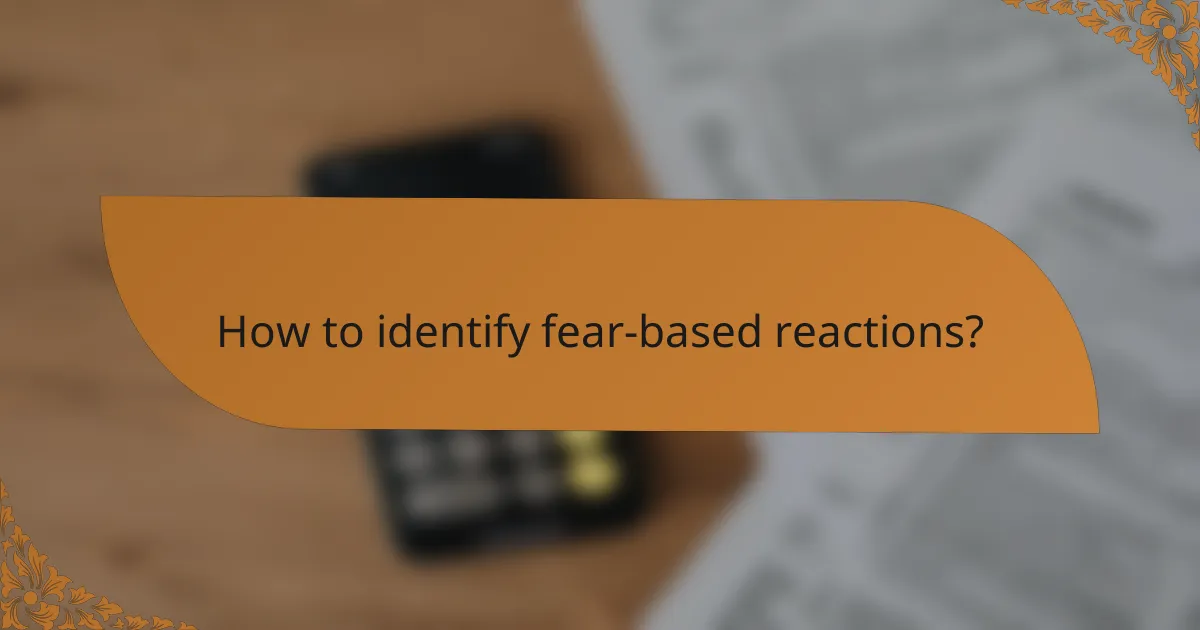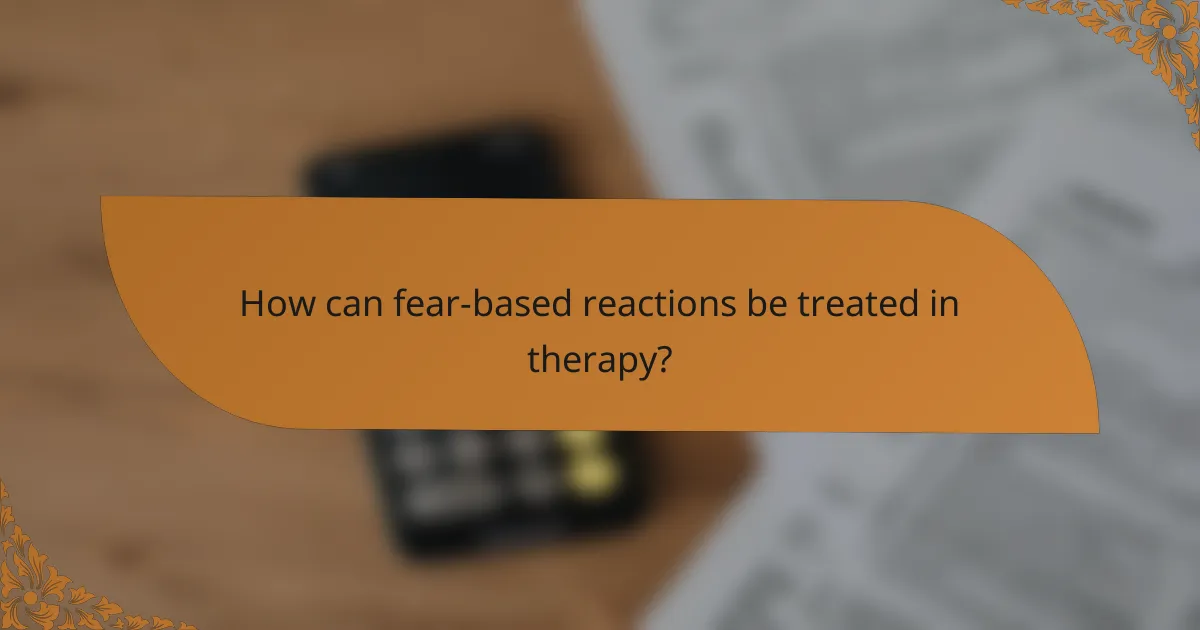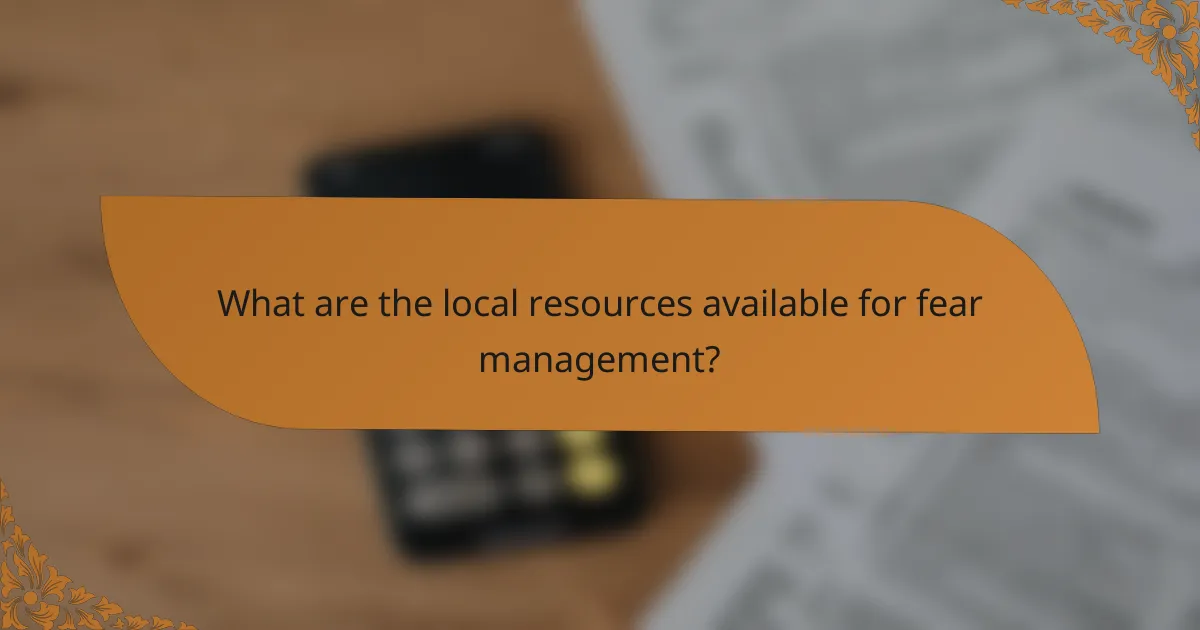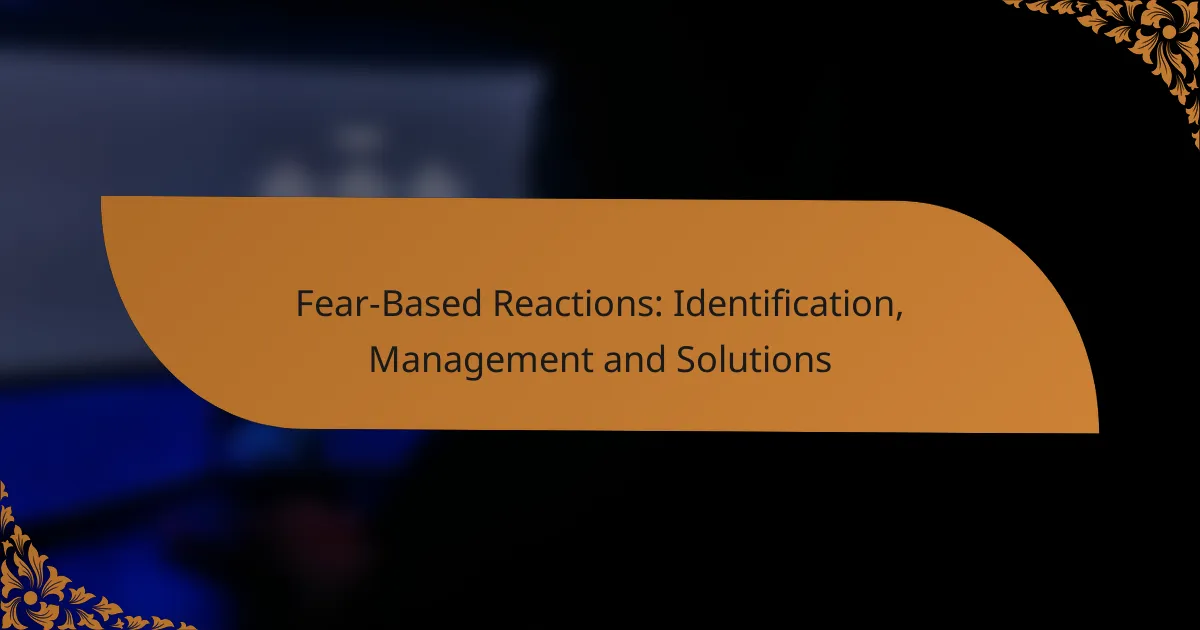Fear-based reactions can significantly impact an individual’s emotional and physical well-being, making it crucial to identify and manage these responses effectively. By recognizing the signs of fear, individuals can develop coping strategies that promote resilience and understanding. Various therapeutic approaches are available to help individuals confront their fears in a supportive environment, ultimately leading to healthier responses and improved quality of life.

How to identify fear-based reactions?
Identifying fear-based reactions involves recognizing physical, emotional, and behavioral signs that indicate fear responses. By understanding these elements, individuals can better manage their reactions and develop effective coping strategies.
Recognizing physical symptoms
Physical symptoms of fear can manifest in various ways, including increased heart rate, sweating, trembling, or shallow breathing. These responses are part of the body’s fight-or-flight mechanism, preparing you to respond to perceived threats.
To identify these symptoms, pay attention to your body when you feel anxious or scared. Noticing changes such as muscle tension or gastrointestinal discomfort can help you recognize when fear is influencing your physical state.
Understanding emotional triggers
Emotional triggers are specific situations, words, or memories that provoke fear responses. Identifying these triggers is crucial for managing fear-based reactions effectively.
Keep a journal to track instances when you feel fear or anxiety, noting the context and your emotional state. This practice can help you pinpoint patterns and develop strategies to address these triggers proactively.
Assessing behavioral responses
Behavioral responses to fear can include avoidance, aggression, or withdrawal. Recognizing how you or others react in fearful situations can provide insights into underlying fears.
Observe your actions in response to fear. For instance, if you tend to avoid social situations due to anxiety, this avoidance behavior can be a clear indicator of fear-based reactions. Understanding these patterns allows for targeted interventions to alter these responses.

What are effective management strategies?
Effective management strategies for fear-based reactions include various therapeutic approaches that help individuals understand and cope with their fears. These strategies focus on changing thought patterns, increasing awareness, and gradually confronting fears in a safe environment.
Cognitive Behavioral Therapy (CBT)
Cognitive Behavioral Therapy (CBT) is a structured, time-limited approach that helps individuals identify and change negative thought patterns associated with fear. By challenging irrational beliefs and replacing them with more balanced thoughts, CBT can reduce anxiety and improve coping mechanisms.
Key steps in CBT include recognizing triggers, understanding the connection between thoughts and feelings, and practicing new behaviors. It often involves homework assignments that encourage individuals to apply learned skills in real-life situations.
Mindfulness techniques
Mindfulness techniques focus on cultivating present-moment awareness, which can help individuals manage fear-based reactions more effectively. Practices such as meditation, deep breathing, and body scans can reduce anxiety by promoting relaxation and increasing emotional regulation.
To incorporate mindfulness into daily life, individuals can set aside a few minutes each day for practice, gradually increasing the duration as they become more comfortable. Apps and guided sessions can also provide structure and support for beginners.
Exposure therapy
Exposure therapy involves gradually and systematically confronting feared situations or stimuli in a controlled manner. This approach helps desensitize individuals to their fears, reducing avoidance behaviors and anxiety over time.
Effective exposure therapy typically follows a hierarchy, starting with less anxiety-provoking situations and gradually progressing to more challenging ones. It’s essential to work with a trained professional to ensure safety and support throughout the process.

How can fear-based reactions be treated in therapy?
Fear-based reactions can be effectively treated in therapy through various methods tailored to individual needs. These approaches often include individual therapy sessions, group therapy, and medication options to help manage symptoms and address underlying issues.
Individual therapy sessions
Individual therapy sessions focus on personal experiences and specific fears, allowing for a tailored approach. Therapists may use techniques such as cognitive-behavioral therapy (CBT) to help clients identify and challenge irrational thoughts that contribute to fear responses.
During these sessions, clients can explore their feelings in a safe environment, develop coping strategies, and gradually confront their fears through exposure therapy. Regular sessions, typically weekly, can lead to significant improvements over time.
Group therapy approaches
Group therapy provides a supportive environment where individuals can share their experiences and learn from others facing similar fears. This format fosters a sense of community and reduces feelings of isolation, which can be beneficial for those struggling with fear-based reactions.
Facilitators often guide discussions and activities that promote understanding and coping strategies. Participants may engage in role-playing or group exposure exercises, which can enhance their ability to manage fear in real-life situations.
Medication options
Medication can be a useful adjunct to therapy for managing fear-based reactions, particularly in cases of anxiety disorders. Common medications include selective serotonin reuptake inhibitors (SSRIs) and benzodiazepines, which can help alleviate symptoms.
It is crucial to consult with a healthcare provider to determine the most appropriate medication and dosage, as individual responses can vary. Medication is often most effective when combined with therapy, providing a comprehensive approach to treatment.

What role does education play in managing fear?
Education is crucial in managing fear as it equips individuals with the knowledge and skills to understand and address their fears effectively. By learning about the psychological and physiological aspects of fear, people can develop coping strategies and reduce anxiety in various situations.
Workshops on fear management
Workshops focused on fear management provide hands-on experience in recognizing and addressing fears. These sessions often include interactive activities, role-playing, and group discussions that foster a supportive environment. Participants can learn techniques such as cognitive restructuring and exposure therapy, which can help them confront their fears in a controlled setting.
Many workshops are available through community centers, mental health organizations, or private practitioners. Costs can vary, typically ranging from free sessions to several hundred dollars for comprehensive programs. Look for workshops that offer follow-up support to reinforce learning.
Online resources and courses
Online resources and courses offer flexible options for individuals seeking to manage their fears from the comfort of their homes. Websites and platforms often provide video tutorials, guided exercises, and forums for discussion. Many courses are self-paced, allowing users to progress according to their own schedules.
Popular platforms like Coursera or Udemy feature courses on anxiety management and emotional resilience, often priced between $20 to $100. Free resources, such as articles and videos from reputable mental health organizations, can also be valuable for those on a budget. Always check for user reviews and course accreditation to ensure quality content.

How to choose the right professional for fear management?
Selecting the right professional for fear management involves assessing their qualifications, experience, and treatment methodologies. It is essential to find someone who aligns with your specific needs and comfort level to effectively address your fears.
Evaluating credentials and experience
When evaluating a professional, start by checking their credentials, such as licenses and certifications relevant to mental health or therapy. Look for qualifications from recognized institutions and memberships in professional organizations that uphold ethical standards.
Experience is equally important; consider how long they have been practicing and whether they specialize in treating fear-related issues. A practitioner with a solid track record in this area is more likely to provide effective support.
Assessing treatment approaches
Different professionals may use various treatment approaches to manage fear, including cognitive-behavioral therapy (CBT), exposure therapy, or mindfulness techniques. Understanding these methods can help you choose a professional whose approach resonates with you.
Ask potential therapists about their specific techniques and how they tailor their methods to individual clients. This can provide insight into whether their approach will meet your needs and help you feel more comfortable during the process.

What are the local resources available for fear management?
Local resources for fear management include support groups and mental health clinics that provide tailored assistance to individuals dealing with fear-based reactions. These resources can help individuals find community support and professional guidance to effectively manage their fears.
Support groups in major cities
Support groups in major cities offer a safe space for individuals to share their experiences and coping strategies related to fear. These groups often meet weekly or bi-weekly and are facilitated by trained professionals or peers who understand the challenges of fear management.
For example, cities like New York and Los Angeles have numerous support groups focusing on anxiety and phobias. Participants can benefit from shared experiences and learn practical techniques to manage their fears in a supportive environment.
Local mental health clinics
Local mental health clinics provide professional services, including therapy and counseling specifically aimed at fear management. These clinics often employ licensed therapists who specialize in cognitive-behavioral therapy (CBT) and other evidence-based approaches to help individuals confront and overcome their fears.
In many regions, clinics may offer sliding scale fees based on income, making mental health services more accessible. It’s advisable to check with local clinics about their specialties and whether they accept health insurance to reduce out-of-pocket costs.

What are the long-term effects of unmanaged fear?
Unmanaged fear can lead to significant long-term effects on mental and physical health. Chronic fear may result in anxiety disorders, depression, and various stress-related illnesses, impacting overall well-being and quality of life.
Psychological effects
Long-term exposure to unmanaged fear can lead to persistent psychological issues such as anxiety disorders, phobias, and depression. Individuals may experience heightened levels of stress, irritability, and difficulty concentrating, which can hinder daily functioning.
Additionally, fear can create a cycle of avoidance, where individuals steer clear of situations that trigger their fear, further isolating them and exacerbating feelings of helplessness. This avoidance can limit personal and professional growth over time.
Physical effects
Chronic fear can manifest physically, contributing to health problems like cardiovascular issues, weakened immune response, and gastrointestinal disorders. The body’s stress response can lead to elevated blood pressure and increased heart rate, which, if sustained, may result in serious health complications.
Moreover, prolonged fear can disrupt sleep patterns, leading to insomnia or other sleep disorders, which can further impair physical health and cognitive function.
Social effects
Unmanaged fear can strain relationships and social interactions. Individuals may withdraw from friends and family, leading to feelings of loneliness and social isolation. This withdrawal can diminish support networks, making it harder to cope with fear and its effects.
In professional settings, fear can hinder collaboration and communication, reducing workplace productivity and job satisfaction. Over time, these social effects can create a cycle that perpetuates fear and anxiety.
